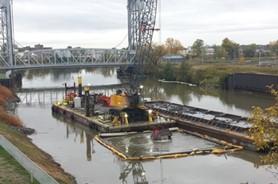Together with the New York Department of Environmental Conservation (NYSDEC) and local and federal partners, the U.S. EPA has announced the removal of the Restrictions on Dredging Activities Beneficial Use Impairment (BUI) at the Buffalo River Area of Concern (AOC). BUIs are designations created by the International Joint Commission that represent different types of significant environmental degradation. See Beneficial Use Impairments for the Great Lakes AOCs to learn more.
Historical industrial activity in this area had resulted in river sediments that contained high concentrations of multiple contaminants, including compounds such as arsenic, barium, and cyanide, and bioaccumulative contaminants such as polycyclic aromatic hydrocarbons (PAHs), polychlorinated biphenyls (PCBs), and mercury. Consequently, special requirements were imposed for disposal of dredged sediments to prevent the release of contaminants back into the environment.
The Buffalo River Restoration Partnership, formed in 2007 by U.S. EPA, NYSDEC, Buffalo Niagara Waterkeeper, U.S. Army Corps of Engineers, the City of Buffalo, and Honeywell, Inc., led the planning and development for sediment remediation work in the AOC. The GLRI supported extensive in-water sediment remediation under the Great Lakes Legacy Act (GLLA). State programs also addressed upland industrial sources of contaminants. Through routine sampling and testing of sediments throughout the AOC, project partners evaluated the remediation work and monitored trends in contaminant levels over time.
The final criteria for removing the Restrictions on Dredging Activities BUI required that sediments dredged from the AOC would not need special handling or disposal due to chemical contamination. Post-remediation monitoring and testing of sediments in the Buffalo River AOC revealed that contaminant levels from most samples collected were below GLLA remedial goal levels. In samples where GLLA levels were exceeded, contaminant levels exhibited decreasing trends indicative of natural ecosystem recovery. Project partners at the U.S. Army Corps of Engineers determined that sediments in the AOC would no longer require special disposal and would be safe for open lake disposal and reuse. Having met the criteria for removing Restrictions on Dredging Activities, the BUI was removed on September 29th, 2022. This is the third BUI to be removed from the Buffalo River AOC.


